skip to main |
skip to sidebar
I'm BAAAAAAAAAAACK! At least for today. This recipe is more for the salad dressing than the salad itself. You can use whatever salad vegetables you like, that you would eat raw. Mine had shredded carrots and beetroot, rocket (arugula), baby spinach, some lettuce of the red-veined variety (who knows what it's called!), tomato wedges, cucumber slices and of course boiled eggs.
Oh, and please ignore the rather gruesome grey-green ring around the yolks. I'm usually pretty deft at getting a perfectly yellow-yolk in my boiled egg, but it so happened that I completely forgot that I had eggs simmering away on the hob. I was distracted by a Facebook status and got sucked in, as you do. I don't know about you, but I blame Mark Zuckerberg. I was loath to throw the eggs away for this blemish and, besides, the green-ringed yolks aren't harmful to eat. So there you have it. By the way, the dressing works rather well with the eggs. I wouldn't have thought it, to be fair.
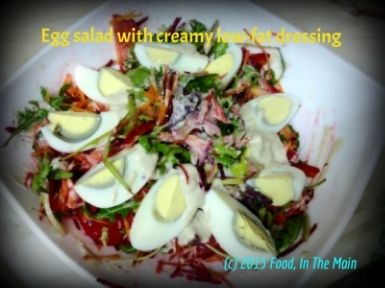
Recipe for: Egg salad with creamy salad dressing
Ingredients
For the salad dressing:
1 tbsp low-fat mayonnaise
4 tbsp Greek or natural yogurt (not sour)
1 htbsp grated parmesan cheese
1.5 tsp Worcestershire sauce
1 tsp lime juice
1 small garlic clove, grated
Freshly ground pepper
pinch of salt
pinch of smoked paprika
For the salad:
1 cup shredded carrots
1/2 cup shredded beetroot
2 medium tomatoes, quartered OR 10-15 cherry tomatoes, halved
1/2 cup cucumber slices
Generous mixture of salad leaves as desired
4 boiled eggs, peeled and quartered
Method:
1. Whisk all the ingredients for the dressing in a bowl. Thin it with a little water, whisking it in, until the dressing is thick but pourable. Adjust the ingredients as required till it tastes good to you. Chill the dressing until required.
2. Put all the salad ingredients in a large bowl and toss them together until evenly distributed. Just before serving, divide the contents between two bowls and dollop most of the dressing over. Mix it into the salad lightly and carefully with your hands fingers or using salad "hands". Place the quartered eggs on top, dab with the remaining dressing and serve at once.
This post is dedicated to a dear blogger whose every post reflects her sincerity and sweetness - Linda OutOfTheGarden(AndLatelyByTheLake). If it hadn't been for her timely rant, you wouldn't be reading this - because there wouldn't have been anything to read. Oh by the way, do read her rant - you'd be hard pressed to find a gentler, sweeter one! When I rant, I rant; when Linda rants... well, she's as likable as ever!
About this recipe, it was meant to be mild and mostly monochrome (white turnip, white pasta, white onion, white mushrooms) but I decided to greenify it a bit by adding spinach and rocket (love the stuff) and a tiny touch of red and heat by way of a fresh red chilli - and then some crunch in the form of pine nuts... and pretty soon it wasn't the original recipe any more. It was better (she said humbly).
Recipe for: Farfalline with turnip, mushrooms and greens
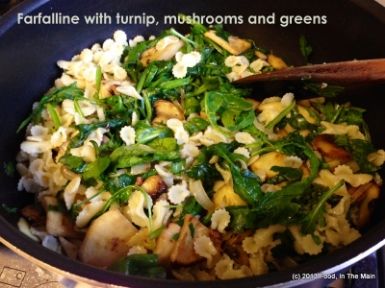
Ingredients:
1/2 cup farfalline or orzo pasta
1 medium turnip, peeled and sliced about 1/4 cm thick and each slice quartered
1 small onion or 2 banana shallots, chopped fine
1/3 cup chestnut mushrooms, sliced
Good handful of spinach leaves, torn
Good handful of rocket leaves
1 red chilli, minced very fine (optional)
1 fat clove garlic, sliced
1 tsp butter
2 tsp olive oil
Salt and pepper to taste
2 tbsp basil and parsley, sliced
1 tbsp toasted pine nuts, for garnish
Method:
1. Cook the orzo/farfalline according to directions in plenty of boiling salted water. Drain, toss with a little olive oil and set aside.
2. Heat 1 tsp oil in a pan and add the garlic, chillies and shallots and stir. Cook over medium heat until the shallots are soft and light brown. Remove from the pan and set aside.
3. In the same pan, heat the remaining oil and butter, add the sliced turnip and mushrooms. Fry until they're golden brown, about 7-8 minutes.

4. Add the cooked shallots to the pan and mix them in. Toss in the spinach and rocket, then stir in the cooked pasta. Add salt and pepper to taste. Stir in the basil and parsley, scatter over the pine nuts, and serve hot or at room temperature.
When I was new to pasta and found out that there were all sorts of different shapes available, I used to imagine that they would all taste different as well, perhaps because of being made from different things (in keeping with the varied shapes). I didn’t realise then that the pasta shapes were made with different styles of sauces in mind – thick and meaty sauces would need large shapes that would hold the sauce, pasta salads would only require small shapes with no "holding" characteristics and so on.
So when a more world-cuisine-savvy friend of mine pointed out that all pasta, no matter the shape or size, were made from durum wheat (with minor variations like the addition of egg or spinach), I was terribly disappointed.
“You mean they all have different names and look different but are made from the same ingredients?" I asked disbelievingly."Yes," he said, uncompromisingly. "Are you quite sure? They're all made from the same ingredients?” I asked for the second time in as many minutes, unwilling to let go of my illusion that each had its own taste.
“Yes, quite sure,” he said again, unable to figure out why I sounded so let-down.
I persisted with my questioning even in the face of his blunt reply. “Then they all taste the same? Just the sauces are different? All the cooked pasta have the same bland taste?"
“YES,” he said, again uncompromisingly but this time with an added edge of irritation.
“But then what’s the POINT?” I wailed.
“What do you mean, what’s the point?” Full-on exasperation, there.
“What’s the POINT of having different shapes if it’s all just the same damn thing? What’s the big deal about pasta then? It’s really the sauce that matters, not the pasta itself.”
And that was when I got the lecture about diff’rent strokes for diff’rent folks, to use a phrase not coined by me in a context probably totally unlike the original coining.
Although I eventually learnt to accept that all pasta may just be pasta but none of them are JUST pasta, still in my heart of hearts there lingers the faint echo of my original outburst... “But what’s the big deal about pasta, then?”
On the other hand, I’ve had people say to me, on being informed that South Indian cuisine is based predominantly around rice with different “sauces” (sambar, rasam, kootu, etc) to flavour it: “But rice is just like pasta then, isn’t it?”
It has been only with the greatest reluctance that I could bring myself to admit that yes, in that ONE way rice IS like pasta... but it’s also so very much MORE than pasta! Different varieties of rice, when cooked, taste and smell different and have different textures. I’m guessing that it’s only of late that scientists have been “inventing” new varieties of rice – but even that is only reinvention (using Nature’s bounty) at best, or tampering (with Nature’s bounty) at worst.
Pasta, on the other hand, completely an artificial invention (seen any pasta fields lately, folks?), has no distinguishing natural characteristics by way of shape or size (beyond those created by humans) or taste (beyond the “taste” of the sauce in which it is dunked).
So, bottomline - no, pasta is most definitely not like rice.
However, over the years, I’ve quite learnt to like pasta and I do understand about the shapes and sizes and uses.
Here’s a recipe with one of each – size, shape and use.
Recipe for: Pasta with rocket (arugula) pesto
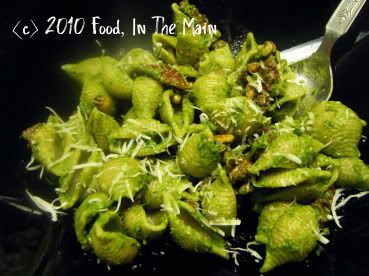
Ingredients:
Whole-wheat pasta - orecchiette or conchigliette for choice, but penne or farfalle will do
4 cups rocket (arugula), washed and patted dry
1/4 cup fresh basil leaves
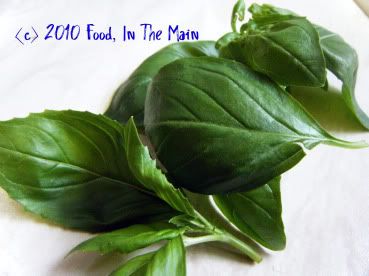
3-4 cloves of garlic
1 tbsp fresh lemon juice
3/4 cup pine nuts (can substitute walnuts)
About 1/4 cup good quality extra virgin olive oil
1/3 cup sundried tomatoes in oil, well drained
Salt and pepper to taste
Grated or shaved Parmigiano reggiano for garnish
Method:
1. Toast the pine nuts in a skillet till golden brown, taking care not to burn them. Set aside to cool.
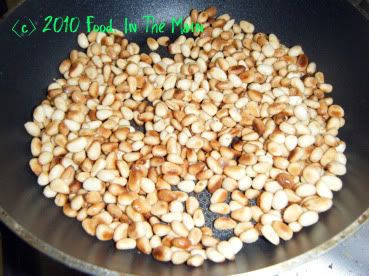
2. In a food processor or mixie, add half the toasted pine nuts (reserving the other half), garlic, rocket (arugula) leaves and basil. Squeeze or pour the lemon juice over the leaves.
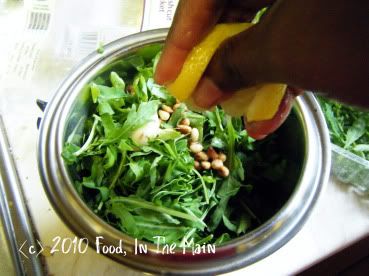
3. Now add olive oil little by little, as required, to help grind the leaves and nuts smoothly.
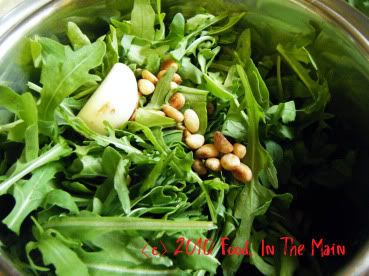
You might not need to use all the olive oil, just use as much as required.
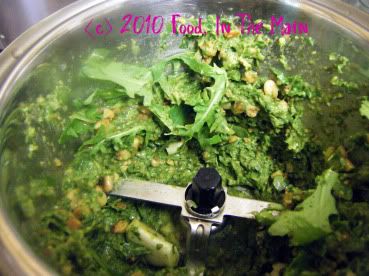
4. When the ingredients have been ground up into a fairly smooth pesto, remove the pesto to a bowl.

5. Add plenty of pepper and salt to taste.
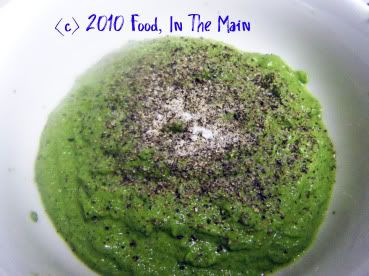
6. Cook the pasta till al dente in plenty of salted water, and drain off the water when the pasta is done. Return the pasta to the pan.
7. Slice the drained sundried tomatoes thinly.

8. Add 3-4 tbsp of the pesto to the pasta and mix in thoroughly. Taste for seasoning and add more pesto if required, making sure that every bit of the pasta is covered.
Add the sliced sundried tomatoes and stir them in,
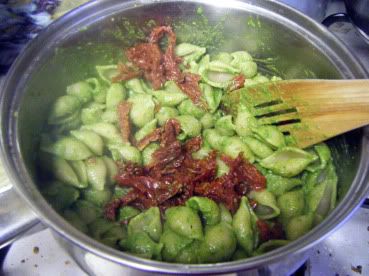
then add the reserved toasted pine nuts. Toss or stir the pasta to distribute the pine nuts evenly.
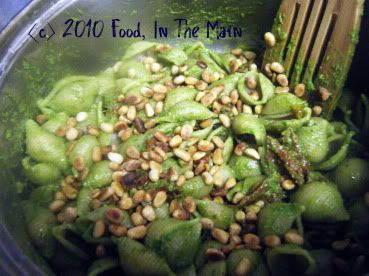
9. Serve the pasta in warmed bowls with generous shavings or gratings of parmigiano reggiano as garnish.















